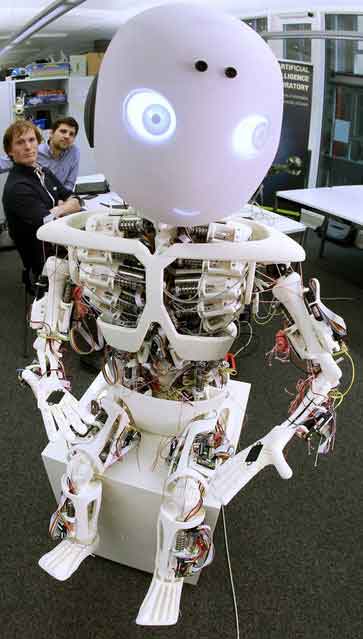
這不是科幻電影!你身邊的小機器人是實實在在的,它們會在不久的將來融入你的生活,陪伴在你左右,并為你的生活提供便捷。它們不再是踩著履帶、布滿電線的冰冷機器,而是一個個憨態可掬、面帶笑容的機器孩子!
By David Szondy
經緯 選 張濤 譯
|
In celebration of the 25th anniversary of the Artificial Intelligence Laboratory Zurich, the University of Zurich presents “Robots on Tour”: World Congress & Exhibition of Robots, Humanoids, Cyborgs and more. It took place on 8th (only for schools) and 9th (public exhibition with approx. 4,000 visitors) March 2013 in Zurich, Switzerland. Over 40 robots from all over the world such as AFFETTO, iCub, Armar, PR-2 and Cornell Ranger will be presented to the broad audience. World-class speakers such as Rodney Brooks attended and as an additional highlight, the AI Lab unveiled its new robot Roboy: Switzerland’s first robotic child! If robots are going to be part of our everyday lives, they’ll need to fit into our homes rather than the factory floor. Few people would be comfortable living with a metal spider on tank treads, so the University of Zurich’s Artificial Intelligence Laboratory (AI Lab) has built this robot toddler called “Roboy.” Using “soft robotics ” technology that mimics the human body, the 1.2 meter (3 ft, 11 in) tall humanoid robot is part of an effort to make robots that people are more comfortable with in day-to-day situations. Roboy doesn’t look very endearing at the moment. In fact, it looks more like a cyborg skeleton than a charming child, but it’s still a work in progress. The laboratory’s goal is to build Roboy in only nine months. Work began June 2012 with 15 project partners and over 40 engineers and scientists. These parties are providing expertise and funds through sponsorship and crowdfunding that includes auctioning space on the robot for logos, and hiring it out for business functions when completed. Built out of plastic, Roboy is modeled on the human musculoskeletal system, but this mimicry goes beyond the aesthetic. Instead of motors in its joints, Roboy uses motor assemblies that pull elastic cables, so the system operates in a way similar to muscles and tendons. AI Lab claims that this will allow Roboy to move “almost as elegantly as a human.” The purpose of Roboy is to push for the acceptance of service robots by making people more comfortable having them around all the time. With an aging population, AI Lab believes that such service robots will be increasingly important in helping the elderly to continue independent lives. Roboy is currently getting a new face chosen by a Facebook contest, and can move its arms. Later, the robot will be covered with a soft skin. Roboy has made its first public appearance at the “Robots on Tour” exhibition on March 9, to celebrate AI Lab’s 25th anniversary, and next it aims to make more people to accept and like it. |
目前,Facebook上在進行一項征集活動,為“機器小子”設計一副新臉龐。另外,“極其小子”還可以轉動胳膊了。不久的將來,它將擁有自己的皮膚。在三月九日的“機器人之旅”展會上,“;機器小子”首次對公眾亮相,以慶祝蘇黎世人工智能實驗室成立25周年,它的下一步目標是讓更多人接受它和喜歡它。 在蘇黎世人工智能實驗室成立25周年慶典上,蘇黎世大學舉辦了一場名為“機器人之旅”的展會。這是一次展示世界范圍內機器人、類人機器人以及半機器人等人工智能產品的盛會。這次大型展會于2013年3月在瑞士首都蘇黎世舉辦,并作為第八屆學生專場和第九屆公眾場吸引了大約四千名參觀者。來自全世界的四十多個機器人,如AFFETTO、iCub、Armar、PR-2和Cornell Ranger將在展會上與廣大觀眾見面。世界頂級機器人專家羅德尼?布魯克斯也將出席此次展會。而作為此次活動的另一個亮點,蘇黎世人工智能實驗室將發布名為“機器小子”的全新機器人,這也是瑞士有史以來第一個機器人孩子! 如果機器人在未來成為我們日常生活的一部分,那么它們需要更加適應我們的家庭而不再是工廠。估計很難有人能接受家里有個靠履帶行走的金屬蜘蛛,因此蘇黎世大學人工智能實驗室把家用機器人設計成孩子的形象,并親切地叫它“機器小子”。“機器小子”個頭有1.2米高,并采用了“軟機器人”技術以模仿人體機能,這樣人們就能在日常生活中更好地接受它。 現階段的“機器小子”看起來并不那么招人喜愛。實際上,它看起來更像是一個半機械的骨架而不是一副令人著迷的孩子形象,但它仍在改進的過程中。實驗室的目標是在九個月內完成“機器小子”。從2012年6月開始就有15個項目合作伙伴以及超過40名工程師和科學家開始參與到這項工作中。各方為此項目提供專業支持,通過贊助和集資的方式為項目提供資金,作為交換,待機器人完成后,他們可以拍賣機器人身上的部位作為商標,或是雇傭機器人,將其用于商業目的。 “機器小子”是基于人體肌肉骨骼系統用塑料進行建模的,但它的這種模擬遠遠超出了人們的審美。“機器小子”所采用的電動機組合能牽引有彈性的線纜進行活動,而不是在關節處安裝發動機,所以整個系統能像肌肉和肌腱組織一樣運行。人工智能實驗室宣稱這將讓“機器小子”幾乎能像人類那樣優雅地完成各種動作。 “機器小子”的問世就是想讓人們感覺到,服務用機器人可以為他們的生活帶來便捷,從而推進服務用機器人的普及。隨著人口老齡化的加劇,人工智能實驗室相信這些服務用機器人在幫助老年人保持獨立生活方面會起到更加重要的作用。 (來源:《英語學習雜志》 編輯:Julie) |
|
Vocabulary: 1. Rodney Brooks: 美國著名機器人制造專家。麻省理工學院電腦科學和人工智能實驗室的現任領導。在20世紀90年代設計了第一個火星機器人。 2. toddler: 蹣跚學步的小孩。 3. soft robotics: 軟機器人技術。指機器人在形態、功能上對人體的模擬。 4. skeleton: 骨架,骨骼。 5. crowdfunding: 集資,合眾籌資。 6. mimicry: 模仿;模擬。 |
